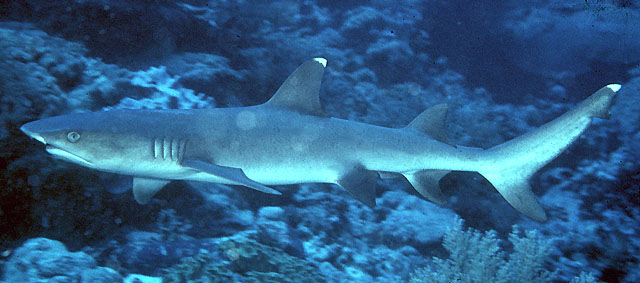| Carcharhinidae (Requiem sharks) |
| 213 cm TL (male/unsexed); max.weight: 18 kg; max. reported age: 25 years |
|
reef-associated; marine; depth range 0 - 330 m |
| Indo-Pacific: Red Sea and East Africa to Indonesia and the Arafura Sea (Ref. 9819), north to Ryukyu and Ogasawara islands, south to New South Wales (Australia), New Caledonia, and the Austral and Pitcairn islands; throughout Micronesia. Eastern Pacific: Cocos and Galapagos islands, Panama to Costa Rica. |
|
Dorsal spines (total): 0-0; Dorsal soft rays (total): 0-0; Anal spines: 0-0; Anal soft rays: 0-0. A small, slender shark with an extremely short, broad snout, oval eyes, and conspicuous white tips on the 1st dorsal (sometimes 2nd) and upper caudal fins; 2nd dorsal almost as large as 1st; no interdorsal ridge (Ref. 5578). Spiracles usually present, teeth 47-50/ 44-46, in at least 2 functional rows. Grey above, lighter below and sometimes with dark spots on sides (Ref. 5578). First dorsal-fin lobe and dorsal caudal-fin lobe with conspicuous white tips, second dorsal-fin lobe and ventral caudal-fin lobe often white-tipped (Ref. 9997). |
| Sluggish inhabitant of lagoons and seaward reefs where it is often found resting in caves or under coral ledges during the day (Ref. 6871, 58302), or usually on a sand patch, or in a channel (Ref. 37816). More active at night or during slack tide in areas of strong currents (Ref. 37816). Feeds on benthic animals such as fishes, octopi, spiny lobsters and crabs (Ref. 244). Viviparous (Ref. 50449). Travels distances from about 0.3 to 3 km in periods up to about 1 year (Ref. 244). Rarely reported to attack humans, but is potentially dangerous especially when fish had been speared (Ref. 244). Probably fished wherever it occurs (Ref. 244). Caught by inshore longline and gillnet fisheries, and probably adversely affected by dynamite fishing (Ref.58048). Meat and liver utilized fresh for human consumption (Ref. 244). The liver of this shark has been reported as toxic (Ref. 583). One to five 60 cm young per litter (Ref. 1602). Minimum depth reported taken from Ref. 128797. |
|
Vulnerable (VU); Date assessed: 16 July 2020 (A2bcd) Ref. (130435)
|
| traumatogenic |
Source and more info: www.fishbase.org. For personal, classroom, and other internal use only. Not for publication.
